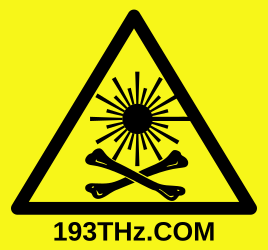
September 2023
Following the conclusions of the previous experiment, the pump diode was connected, with a series resistor, to a LT3042-based low-noise voltage regulator module from Aliexpress. The pump/output heterodyne signal looked a lot better than with the Rigol unit, but there were sidebands every few MHz, which seem to be coming from a small high-frequency oscillation produced by the module. The corresponding sidebands were not present in the SBS laser output, so it looks like the phase modulation of the DFB output that it produced simply distorted the Brillouin gain curve without too much impact on the SBS laser. Adding small ceramic capacitors at the output of the regulator made the sidebands mostly disappear. This module, however, has substantial low-frequency noise which is due at least in part to its temperature sensitivity (blowing hot air on it causes a lot of mode sweeping in the SBS laser) and mode hops still occur every couple hundred milliseconds without a control loop.
A simple control loop was put in place by detecting the peak frequency in the pump/output heterodyne signal, subtracting a frequency setpoint, and implementing a proportional controller that modulates the TEC current produced by a precision Sinara 8451 thermostat. This was an opportunity to try out some of the upcoming C++23 features, in particular the Networking TS, which are looking quite good. This simple system was able to keep the laser stable for several minutes in the absence of substantial external disturbances. The software was also improved to plot the lineshape (coming from a delayed self-heterodyne measurement) in synchrony with the pump/heterodyne signal, so that the correlation between the two can be easily seen.
The LT3042-based regulator was replaced with part of a Kirdy laser driver prototype. This is a much more sophisticated design based on the LTC6655 precision voltage reference, MAX5719 20-bit low-noise DAC, and ADA4898 high-speed low-noise op-amps driving a power MOSFET as a constant-current source. The performance of this device is excellent, with the SBS laser remaining stable for several seconds with the control loop disabled and no visible effect from hot air being blown on the laser driver. Engaging the proportional controller after the pump laser warmed up resulted in an easy lock that appears to remain stable indefinitely (as long as the fiber cavity isn't disturbed).
Even when the laser is running stable, a side mode is still weakly present about 30dB-40dB below the main line (note that the display saturates on the screenshots, so it looks worse than it actually is). To put this number into perspective, blocking one polarization of a two-mode stabilized HeNe laser with a commonly available polarizer results in a SMSR of 20dB-30dB, a typical telecom DFB has a SMSR of 35dB-40dB, and IPS laser diodes can reach 70dB with a passive optical filter (in the case of this SBS laser, since the side mode is so close, a more complicated filter based on an actively stabilized cavity would probably have to be used).
The control loop does not need to involve fancy hardware, i.e. a X-band downconverter, SDR, and PC are not required. In normal operation, the pump/heterodyne signal consists of a strong single frequency component. This 10.6GHz signal could be sampled in a high-order Nyquist zone using a high-speed flip-flop such as the NB7V52M, whose output could then be easily processed by a low-end CPLD or even the timer unit of a microcontroller. We are not interested in the exact value of the Nyquist order since we only want to measure the frequency variations within a bandwidth of a few MHz. We simply need to know whether the Nyquist order is odd or even, so that the correct sign for the error signal can be determined. This can be done entirely in firmware by looking at the direction of the measured frequency change as the pump laser is being cooled. We also want to stay clear of the boundaries of the Nyquist zone to avoid flip-flop metastability and other difficulties with the frequency measurement. This can be done by adjusting the sample rate using a precision programmable oscillator (for example Skyworks Si549) to drive the flip-flop clock. This all could be integrated on a small add-on module for Kirdy, which would make for a simple and compact SBS laser controller.